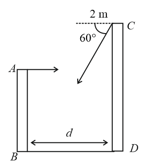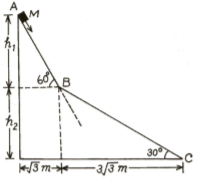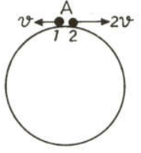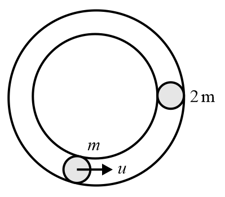Collisions
Collisions: Overview
This topic covers concepts, such as, Collisions, Inelastic Collision, Linear Impulse and Coefficient of Restitution & Collision and Vertical Circular Motion etc.
Important Questions on Collisions
Two towers and are situated a distance apart as shown in figure. is high and is high from the ground. An object of mass is thrown from the top of horizontally with a velocity of towards . Simultaneously another object of mass is thrown from the top of at an angle of to the horizontal towards with the same magnitude of initial velocity as that of the first object. The two objects move in the same vertical plane, collide in mid-air and stick to each other. Find the position where the objects hit the ground (from ).

A small block of mass moves on a frictionless surface of an inclined plane, as shown in the figure. The angle of the incline suddenly changes from to at point B. The block is initially at rest at A. Assume that collisions between the block and incline are totally inelastic. . 
A block of mass is moving with a speed of on a smooth surface. It strikes another mass of and then they move together as a single body. The energy loss during the collision is:
Two small particles of equal masses start moving in opposite directions from a point in a horizontal circular orbit. Their tangential velocities are and , respectively, as shown in the figure. Between collisions, the particles move with constant speeds. After making how many collisions, other than that at , these two particles will again reach the point ?

A smooth sphere is moving on a frictionless horizontal plane with angular speed and centre-of- mass velocity . It collides elastically and head-on with an identical sphere at rest. Neglect friction everywhere. After collision, their angular speeds are and respectively. Then:
Consider a rubber ball freely falling from a high height on to a horizontal elastic plate. Assume that the duration of collision is negligible and the collision with the plate is totally elastic. Then the velocity as a function of time and the height as a function of time will be:
Two particles of masses and , in projectile motions, have velocities respectively at . They collide at time . The velocities become and at time while moving in air. The value of is
A point mass of collides elastically with a stationary point mass of . After their collision, the mass reverses its direction and moves with a speed of . Which of the following statements is correct for a system of these two masses?
Two objects of the same mass and with the same initial speed, moving in a horizontal plane, collide and move away together at half their initial speeds after the collision. The angle between the initial velocities of the objects is,
Two masses and are placed in a fixed horizontal circular smooth hollow tube as shown. The mass is moving with speed and the mass is stationary. After their first collision, the time elapsed for next collision is (Coefficient of restitution is, )

A particle of mass and velocity collides head-on with a stationary particle of mass . After collision the velocity of both particles is . The energy lost in the collision is:
A proton of mass a.m.u. collides with a Carbon- nucleus (mass = a.m.u.) at rest. Assuming that the collision is perfectly elastic and that the Newton's laws of motion hold, what fraction of the proton's kinetic energy is transferred to the Carbon nucleus ?
Two identical spheres and lie on a smooth horizontal circular groove at opposite ends of a diameter. is projected along the groove and at the end of time , impinges on . If is the coefficient of restitution, then the second impact will occur after the shortest time of
A tennis ball is released from height above ground level. If the ball makes inelastic collision with the ground, to what height will it rise after the third collision, is the coefficient restitution between ball and ground?
A body of mass moving with an unknown velocity of undergoes a collinear collision with a body of mass moving with a velocity After the collision, and move with velocities of and respectively. If and then is:
A metal ball falls from a height of on to a steel plate and jumps up to a height of . The coefficient of restitution of the ball and steel plate is
A smooth sphere is moving on a frictionless horizontal plane with angular speed and centre of mass velocity . It collides elastically and head-on with an identical sphere at rest. Neglect friction everywhere. After the collision, their angular speeds are and respectively. Then,
When two bodies collide elastically, the force of interaction between them is
Coefficient of restitution during the collision is changed to keeping all other parameters unchanged. What is the velocity of the ball after the collision?
A sphere having mass moving with a constant velocity hits another stationary similar sphere. If is the coefficient of restitution, then ratio of speed of the first sphere to the speed of the second sphere after collision will be:
